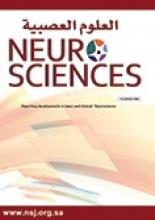Abstract
OBJECTIVE: Due to the poor results achieved on combination chemotherapy and the unproven cost-effectiveness value of myeloablative therapy, the question has been raised; should patients with stage IV neuroblastoma be actively treated? The aim of the current study is to analyze retrospectively treatment results of 43 children with neuroblastoma with special stress on the rate and duration of remission in children with disseminated neuroblastoma.
METHODS: Treatment of children with neuroblastoma consisted of surgical removal of the tumor, if possible, followed by chemotherapy for unresectable residual tumor including metastases. Second look surgery was performed to resect residual masses rendered resectable on chemotherapy in the absence of distal metastases. The chemotherapy protocol used in the current study consisted of alternating combination chemotherapy regimens containing, Cyclophosphamide, Vincristine and Doxorubicin, alternating with Cis-platinum and Etoposide.
RESULTS: The male to female ratio was 2:1 with a median age of 2.1 years. The abdomen was the primary site of involvement encountered in 32 patients (74%). According to the childrens cancer study group (CCSG) staging system, only 6 patients (14%) had localized tumors (stages I and II). Two patients (5%) were found to have stage IV. Stage III was documented in 5 patients (12%). The majority of patients (70%) had disseminated disease at presentation. The bone marrow was the most common site of metastatic deposit, encountered in 23 patients out of the 30 with stage IV disease (77%). Out of the 12 evaluable non-stage IV patients, only one patient (8%) showed treatment failure. Assessment of response by the end of the 6th month from the date of diagnosis revealed that out of the 27 evaluable patients with stage IV, 4 patients achieved complete remission, 7 patients achieved very good partial remission, 8 patients achieved partial remission and 4 patients achieved mixed response. Three patients showed progressive disease on chemotherapy. Twenty-one patients (78%) were symptom-free and were conducting normal life. Assessment of response to treatment by the end of the 12th month from diagnosis revealed that 6 patients (2 complete remissions, 1 very good partial response, 3 partial responses) were maintaining their remission. Out of the 19 patients showing complete or partial remission at early assessment, 4 patients maintained their remission for more than 18 months. Two (one was in complete remission and the other was in partial response) of them progressed in areas of previous involvement after 20 and 21 months. The other 2 patients (one was in complete remission and the other was in partial response) showed disease progression in areas not previously affected by disease at presentation after 23 and 42 months.
CONCLUSION: Results of treatment by multiagent chemotherapy regimens used in the current study show that children with neuroblastoma, even those with advanced stages, should receive the benefit of intensive multimodal therapy, even those with partial response to initial therapy. These patients may experience reasonable symptom-free and sometimes, disease-free survival.
- Copyright: © Neurosciences
Neurosciences is an Open Access journal and articles published are distributed under the terms of the Creative Commons Attribution-NonCommercial License (CC BY-NC). Readers may copy, distribute, and display the work for non-commercial purposes with the proper citation of the original work.






